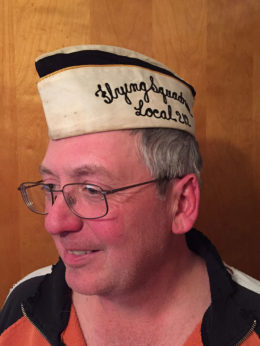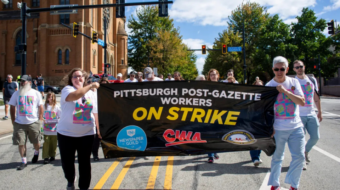
This article won Third Place Best Labor History Story in the 2018 International Labor Communications Association’s Labor Media Awards.
A flea market on a Sunday afternoon. Not the kind of place you would normally find me. I have too much stuff and why does anyone look for more crap to buy? But here I am and there it was. My eyes instantly drew to the sweat stained, yellowed cap with the feathered insignia. It was lying amongst some military paraphernalia, assorted badges, and knives that the “HOORAH” aficionados normally salivate over. I recognized it right away.
This was no piece of U.S. military history. The insignia, circled with protruding wings, proclaimed “UAW 212 CIO.” With excited hands I flipped the cap over. “Flying Squadron Local 212” was cursively embroidered on the back side. I hollered through the din of the flea market: “Whose table is this?” A young man answered, “What you got there?” I held up the cap and asked him how much. I was trying like a third grader just getting up from his desk after staring at an attractive teacher not to show how excited I was.
“Ten bucks for the cap,” the young lad answered. With nary a shake or a nod I gave him the ten-spot and scurried away from his booth. I placed the cap on my head. I felt history seeping into the pores of my scalp. That feller had no idea what he had just sold.
The 1930s were a violent and tumultuous time for union organizing in Detroit. The UAW, as well as many other unions in the area, were met with vicious and gruesome physical attacks by company security forces known as “goons” as well as some city’s police departments.

Union organizers and supporters were beaten and bullied and sometimes killed by these company thugs in their bloodthirsty attempts to keep out the unions. In response to this, the Flying Squadrons were formed. They were the tough guys in the UAW locals who responded when the company goons were trying to crack heads. They dressed in paramilitary fashion with matching jackets and caps adorned with pins and badges. They were the guys who stood outside of union halls as the guards in case the company goons tried to crash the union meetings. They were the “enforcers” for the union and, most of the time, their mere presence prevented any violence before it began.
The Flying Squadron of UAW Local 212 was the most famous of these groups.
UAW Local 212 was the strongest local on Detroit’s east side during the 1930s and 1940s. The local’s contributions to the building of the UAW into a strong organization were without equal.
Local 212 was the largest local in the UAW and represented the workers at the Briggs Manufacturing Company, an automobile parts supplier. Walter Briggs, the owner of the company, was probably more renowned for his ownership of the Detroit Tigers and its ballfield, Briggs Stadium, later known as Tiger Stadium. Briggs’ fame and popularity came from his ownership of the baseball team and its venue. Most people of Detroit did not relate Walter Briggs to his car company and certainly not to the unfair labor practices for which his company was famous within the labor movement.
The Flying Squadron of Local 212 was instrumental in sustaining and assisting in many of the labor battles within the Briggs Manufacturing Company, but its most infamous moment in Detroit labor history came when the squad assisted in a 1941 melee during a UAW strike against the Ford Motor Company.
Detroit News photographer Milton Brooks captured an image of half a dozen Local 212 Flying Squadron men reacting to a Ford thug. In the photo, Jess Ferazza is shown giving a dropkick to a doubled over Ford serviceman being held by other Local 212 Flying Squadron men. At the same time, another Flying Squadron man has a bat raised and is about to swing the bat down on the Ford goon. A vicious picture, but even the photographer’s later comments acknowledge that the Ford Service Men initiated the violence. Milton Brooks, the photographer, won a Pulitzer Prize for the photo; the company goons won a few black eyes and broken ribs. For every action there is a reaction.
I will never know on whose head this UAW Local 212 CIO Flying Squadron cap was proudly displayed or whose sweat still stains its brim. I know with all my heart that it was a strong, valiant man (or maybe a woman?) who was defending his union with all his passion and honor. If the need arises, and I hope it never does, I hope that I can be that brave.










